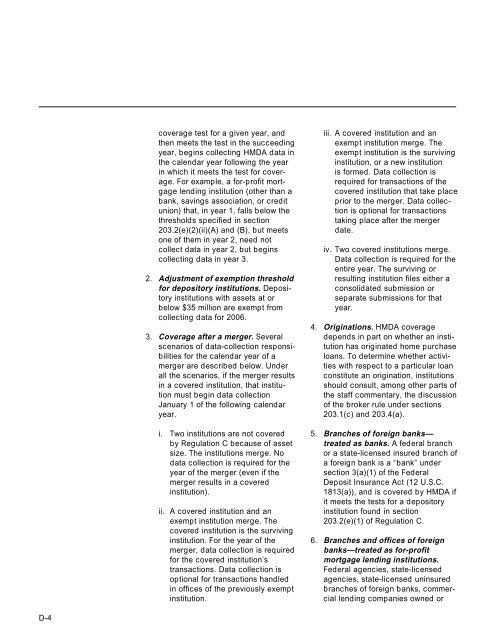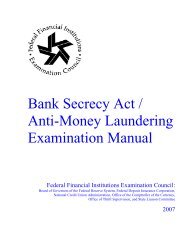A Guide to HMDA Reporting - ffiec
A Guide to HMDA Reporting - ffiec
A Guide to HMDA Reporting - ffiec
You also want an ePaper? Increase the reach of your titles
YUMPU automatically turns print PDFs into web optimized ePapers that Google loves.
D-4<br />
2.<br />
3.<br />
coverage test for a given year, and<br />
then meets the test in the succeeding<br />
year, begins collecting <strong>HMDA</strong> data in<br />
the calendar year following the year<br />
in which it meets the test for cover-<br />
age. For example, a for-profit mortgage<br />
lending institution (other than a<br />
bank, savings association, or credit<br />
union) that, in year 1, falls below the<br />
thresholds specified in section<br />
203.2(e)(2)(ii)(A) and (B), but meets<br />
one of them in year 2, need not<br />
collect data in year 2, but begins<br />
collecting data in year 3.<br />
Adjustment of exemption threshold<br />
for deposi<strong>to</strong>ry institutions. Deposi<strong>to</strong>ry<br />
institutions with assets at or<br />
below $35 million are exempt from<br />
collecting data for 2006.<br />
Coverage after a merger. Several<br />
scenarios of data-collection responsibilities<br />
for the calendar year of a<br />
merger are described below. Under<br />
all the scenarios, if the merger results<br />
in a covered institution, that institution<br />
must begin data collection<br />
January 1 of the following calendar<br />
year.<br />
i. Two institutions are not covered<br />
by Regulation C because of asset<br />
size. The institutions merge. No<br />
data collection is required for the<br />
year of the merger (even if the<br />
merger results in a covered<br />
institution).<br />
ii. A covered institution and an<br />
exempt institution merge. The<br />
covered institution is the surviving<br />
institution. For the year of the<br />
merger, data collection is required<br />
for the covered institution’s<br />
transactions. Data collection is<br />
optional for transactions handled<br />
in offices of the previously exempt<br />
institution.<br />
4.<br />
iii. A covered institution and an<br />
exempt institution merge. The<br />
exempt institution is the surviving<br />
institution, or a new institution<br />
is formed. Data collection is<br />
required for transactions of the<br />
covered institution that take place<br />
prior <strong>to</strong> the merger. Data collection<br />
is optional for transactions<br />
taking place after the merger<br />
date.<br />
iv. Two covered institutions merge.<br />
Data collection is required for the<br />
entire year. The surviving or<br />
resulting institution files either a<br />
consolidated submission or<br />
separate submissions for that<br />
year.<br />
Originations. <strong>HMDA</strong> coverage<br />
depends in part on whether an institution<br />
has originated home purchase<br />
loans. To determine whether activities<br />
with respect <strong>to</strong> a particular loan<br />
constitute an origination, institutions<br />
should consult, among other parts of<br />
the staff commentary, the discussion<br />
of the broker rule under sections<br />
203.1(c) and 203.4(a).<br />
5. Branches of foreign banks—<br />
treated as banks. A federal branch<br />
or a state-licensed insured branch of<br />
a foreign bank is a “bank” under<br />
section 3(a)(1) of the Federal<br />
Deposit Insurance Act (12 U.S.C.<br />
1813(a)), and is covered by <strong>HMDA</strong> if<br />
it meets the tests for a deposi<strong>to</strong>ry<br />
institution found in section<br />
203.2(e)(1) of Regulation C.<br />
6.<br />
Branches and offices of foreign<br />
banks—treated as for-profit<br />
mortgage lending institutions.<br />
Federal agencies, state-licensed<br />
agencies, state-licensed uninsured<br />
branches of foreign banks, commercial<br />
lending companies owned or
















